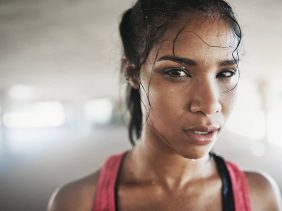10 flexibility exercises to get you feeling looser
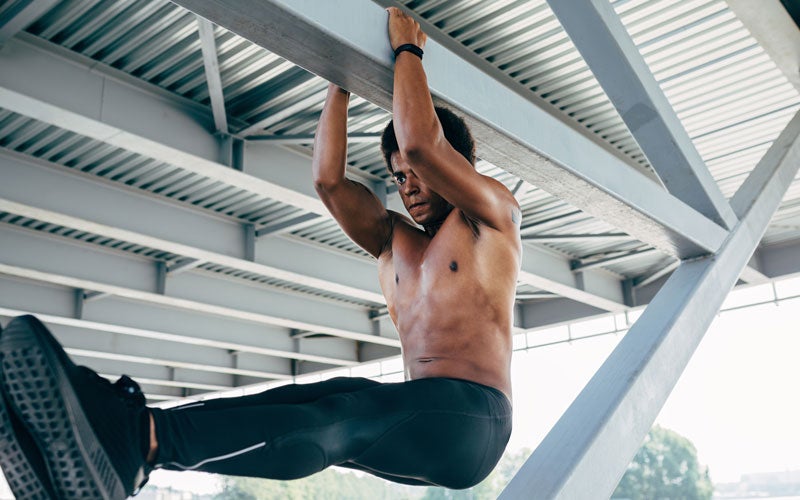 © foodspring
© foodspring
Want to be successful with your fitness routine in the long term? Pay attention to your agility, mobility, and flexibility! In this article we’ll get into why this group of skills is so important, and show you the best flexibility exercises for your warm-up.
Mobility, agility, flexibility: all of these concepts are different, but their boundaries are fluid depending on your particular exercise philosophy. We’ll start with flexibility, since it’s usually considered one of the 4 basic components of fitness alongside strength, endurance, and speed.
What is flexibility?
Flexibility is all about each muscle’s ability to stretch individually. It’s often thought of in terms of range of motion as well, and that’s how it’s related to mobility, which is your joints’ range of movement. Agility then adds in coordination so your body’s movements are quick and easy. To reach your full potential in any one of these skills, you need to work on the other two, and all together they help keep your musculoskeletal system healthy over the long term.
When all three are up to par…
- Muscles, tendons, and ligaments can reach their peak performance.
- They work together to help you excel at the sport you’re practicing.
- Your coordination is good enough to make use of your full range of motion.
Simply put, you can perform all the movements that a healthy body is capable of without muscular imbalances or tension. Some general conditions, such as the range of motion of a joint determined by the bone structure, apply to everyone, while others depend on how your individual body is put together.
For your body to function at its peak and feel good, getting the right nutrients is essential. Premium superfoods help optimize your nutrition around your workout plan and challenging daily schedule.
Your range of motion might be limited by…
- your bone structure.
- the elasticity of ligaments, tendons, fascia, connective tissue, skin, and subcutaneous tissues.
- muscle tone.
- lopsided musculature.
- strengths and weaknesses conditioned through exercise & everyday life.
- gender, age, amount of exercise over the past few years.
As you can see, there are many factors that influence these skills. You are at your most flexible during your childhood. While your strength, speed, and endurance increase as you grow up – at least to a certain extent – your mobility decreases. Sitting a lot and other lopsided postures in everyday life further reduce your flexibility, putting you at a disadvantage both at the gym and in everyday life.
The bad news is that flexibility also decreases when you exercise regularly. During muscle building or extensive running training, for example, your muscle tone increases, while running puts an uneven strain on your body. Both of these lead to less agility.
The good news is: You can improve your mobility! Sure, you may not slide into the splits right away, but you’ll still get closer to touching your toes.
General agility and sport-specific agility
Fortunately, you also probably don’t have to slide into the splits. In functional training, especially, sport-specific agility is what’s important. In other words, what range of motion and level of coordination do you need to make progress in your particular sport?
For a good squat, for example, you need mobility in the ankle joints and flexibility in your calf muscle to get your heels on the ground. The main problem is usually a limited range of motion in the ankle. Your hamstrings also need to be able to stretch so your lower back can stay long during a deep squat.
General agility, on the other hand, means you’re able to use the full range of motion you need in your daily life.
The difference between mobility & flexibility exercises
To review: flexibility is more about each muscle’s ability to stretch, while mobility refers to the active movement of your joints in all possible directions.
You can work on your flexibility with passive stretches, by going into a hamstring stretch while sitting, for example. In active mobility exercises, your muscles initiate an ongoing movement.
For example, in flexibility exercises, you would do a quad stretch, while mobility training would involve bending your knees and moving them in circles. Work with both of these categories and your overall agility will improve.
Because your mind and body are connected, there’s also other factors at play in your performance. Stress has been shown to increase muscle tension, which, in turn, makes you less flexible. Take the time to breathe deeply and relax with a cup of tea, for example. Sounds old-fashioned, but it really works if you take the time to do it.
Get to know our Functional Teas
Why should I work on my agility?
Don’t care if you can’t touch your toes? Well, you should! Regular agility training will help you improve in your sport, keep your entire musculoskeletal system healthy over the long term, and otherwise help you meet your exercise goals.
- To stay healthy, in your lower back, for example
Flexibility is one of the fundamental components of fitness on its own merits, but you also need it to develop your full potential in strength and speed. It’s really just stamina that doesn’t have a direct connection to mobility.
Even in old age, agility contributes to greater freedom of movement and improved health overall. Stretches for more mobility for seniors are a gentle form of working out and increasing joint circulation.
- To move more smoothly
Stretching exercises help you avoid bad posture due to too much muscular tension on one side. Of course, you still have to work out in a balanced way to build muscle correctly. Extra mobility training on top of that supports a healthy posture and dynamic, light movements, which feel and look better than stiff movements.
- To improve your weightlifting performance
Good mobility and coordination are the prerequisites for many movements. This starts with basic moves like the squat and ends with complex ones like the clean and jerk. To perform these lifts correctly, you need a minimum range of motion in your ankle joints, hamstrings, hips, thoracic spine, and shoulders.
You don’t have to do yoga 3 times a week to achieve this level of agility. Just devote 10 minutes of your warm-up to some stretches.
What happens during flexibility training
Colloquially we often talk about shortened muscles but, from a technical point of view, that’s inaccurate. They don’t actually get longer or shorter once you’re done growing. Instead, regular stretching balances out the effects of strength training, stress, and lopsided strain from daily life.
- Muscle tightness eases.
- The muscle’s ability to relax improves.
- Overall tension is reduced.
- Range of motion improves.
When a muscle tenses, its number of titin filaments increases, and they, in simple terms, are what’s responsible for contracting the muscle. Agility training does not reduce the titin filaments, instead it makes sure that the muscle still remains elastic despite them.

Can I build muscles and my agility at the same time?
Definitely! As we explained above, you also need a good range of motion to perform many movements well. Executing these exercises with perfect form is a prerequisite for maximum performance and effective strength building.
However, too much range of motion isn’t always a good thing, because it can make your joints unstable and more prone to injury. For example, for an overhead squat, you need to have not only enough mobility in your shoulders, but also enough strength to stabilize them and keep the weight in place.
Also, when you’re running, your hip flexor should be able to stretch, but at the same time you should have enough core stability to maintain good running technique. Some stretches, such as a long lunge, require a certain amount of strength to perform them at all.
How can I improve my agility?
The best way to improve your agility is to work on it regularly. Go to yoga classes, or just incorporate regular exercises into your workouts and stretch as part of your cool–down.
Strength and coordination – especially intramuscular coordination, which is the fine-tuning of muscle fibers within a muscle – are also part of good mobility training. So don’t force yourself into any extreme stretching positions, but ease into each position slowly so you work on your coordination as well. Only go as far as you can while still controlling the motion.
Before you start training these skills, ask yourself what your goal is. Why do you want to become more flexible? To stay healthy and counteract imbalances? To avoid injuries? To get better at your sport? To relax?
Once you’ve figured out what your focus is, you can customize your flexibility exercises.
For classic static stretching like many yoga poses, where you hold the stretch for 30-40 seconds, you should warm yourself up to minimize the risk of injury. That’s why static stretching is best done after a light run or workout.
Dynamic stretches, on the other hand, are perfect as a warm-up or 5-minute break from desk work.
Build a solid foundation for a productive workout routine and improved agility with a balanced diet. For those days when it’s more difficult to get your fruits and veggies, our Daily Vitamins provide your body with all the important vitamins it needs.
Learn more about Daily Vitamins
10 Mobility Exercises for Your Everyday Life
To warm you up for your workout and to stay mobile in your everyday life, it’s a good idea to move through all your major joints once. That’s why we designed our 10 flexibility exercises for your daily life.
-
Neck circles
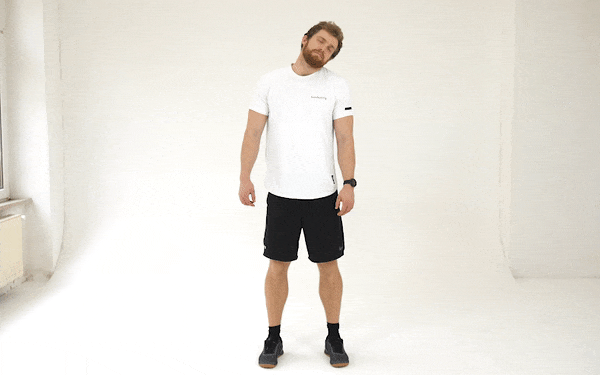
Effect:
Relaxes and gets your neck and shoulders moving.
Instructions:
Circle 5 times in one direction, 5 times in the other. Do 3 sets for each side.
Tip:
Close your eyes to increase the relaxation effect.
-
Arm circles
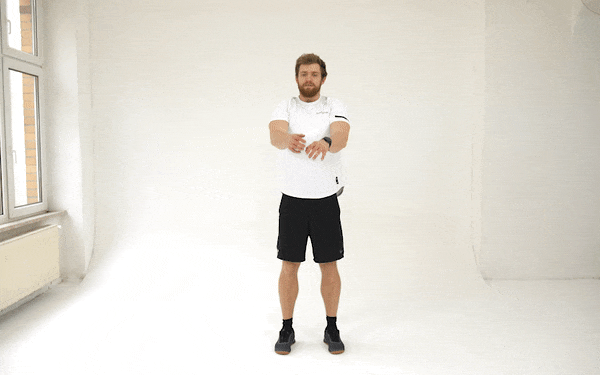
Effect:
Improves shoulder and arm range of motion, opens the chest slightly.
Instructions:
Circle 5 times in one direction, 5 times in the other. Do 3 sets for each side.
Tips:
Keep your arms long and relaxed. Choose a speed that feels good for you.
-
Chest and shoulder opening
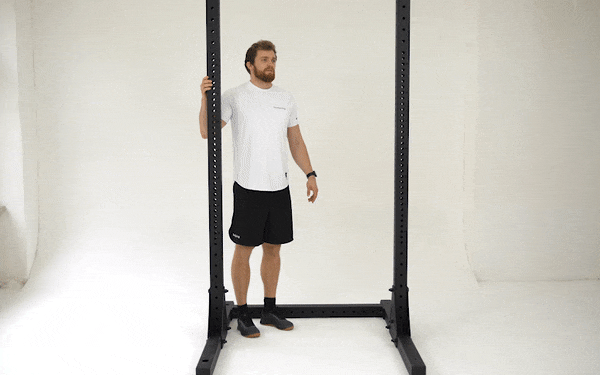
Effect:
Stretches your chest muscles.
Instructions:
Hold each stretch for 20 seconds. Do two sets per side. Use a door frame if you’re stretching at home or the office.
Tip:
Gently pull your arm back far enough to feel a stretch in the muscle but not so far that it hurts.
-
Hip circles
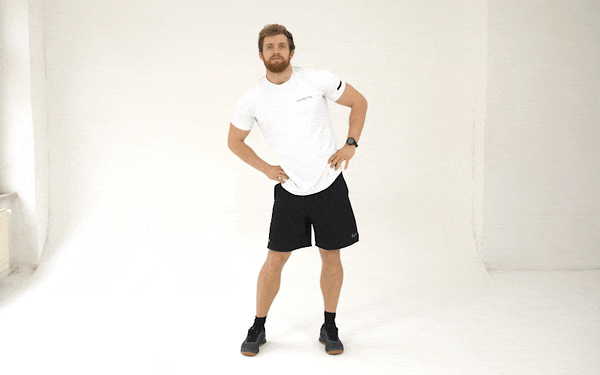
Effect:
Loosens hip and core muscles. Improves hip mobility as well.
Instructions:
Circle 5 times in one direction, 5 times in the other. Do 3 sets for each direction.
Tips:
Keep your feet at hip width with knees slightly bent. Relax your hips.
-
Knee circles
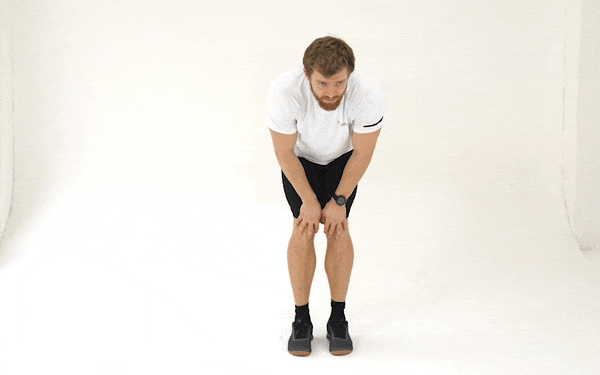
Effect:
Loosens up quads and glutes.
Instructions:
Circle 5 times in one direction, 5 times in the other. Do 3 sets for each direction.
Tips:
Keep your feet hip width apart with your hands on your thighs. Knees move in opposite directions.
-
Lateral stretching
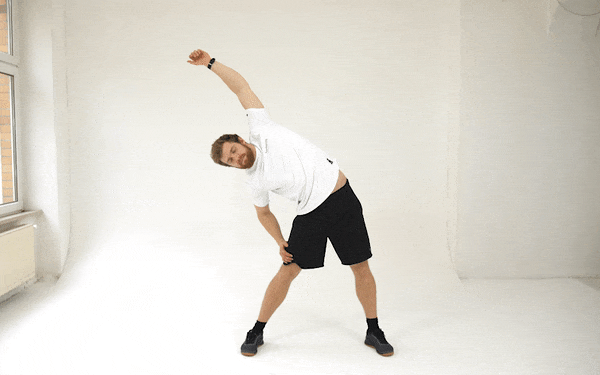
Effect:
Stretches the lateral abdominals and back muscles. Also improves spine mobility.
Instructions:
Stretch out to the side and down when you exhale and hold it briefly. When you breathe in, come back up and go to the other side when you exhale. 5-8 times per side.
Tips:
Feet are set farther apart than your hips. Your upper body stretches straight to the side, not towards the front or back. Gaze toward your outstretched arm.
-
Toe touches
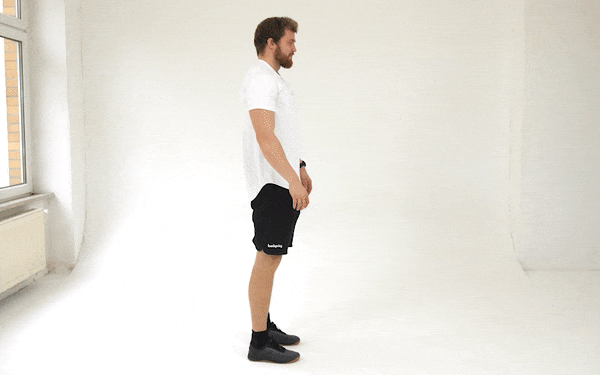
Effect:
Stretches your back and the back side of your legs.
Instructions:
Roll down slowly vertebrae by vertebrae, relax for a moment at the bottom, let your head hang loosely. Roll up slowly again vertebrae by vertebrae. Repeat 5 times.
Tip:
Only roll as far down as you can without pain in your back. Perform the exercise with your knees bent if necessary.
-
Deep lunge and shoulder rotation
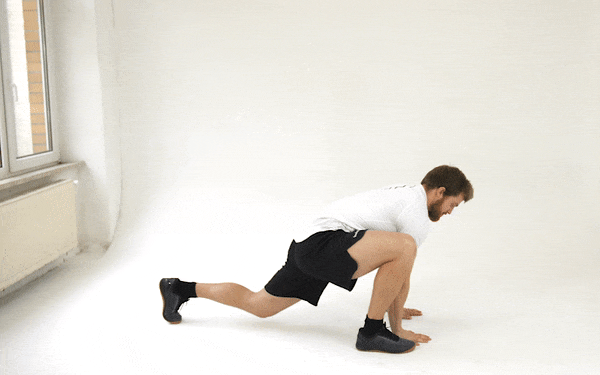
Effect:
Stretches and loosens up hip flexors and hamstrings, improves spine and shoulder mobility.
Instructions:
Hold both shoulders in a straight line briefly before you switch sides. 5 reps per side.
Tips:
Your hips stay level, pelvis is upright.
-
Deep squat and back extension
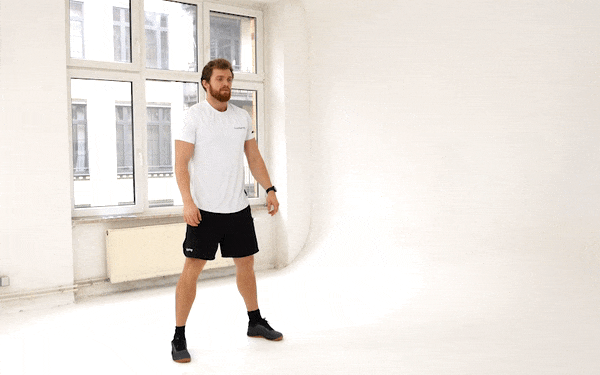
Effect:
Improves ankles’ range of motion, stretches hamstrings, extends the lower back, opens the chest section of the spine, strengthens all muscles involved.
Instructions:
Stay for a moment in the squat and take the time to really stretch your upper body before you come up again.
Tips:
Keep your weight over your heels, knees point the same direction as your feet. If your heels come up off the floor, or it’s difficult to keep your back straight, put something underneath your heels.
-
Foot rotation

Effect:
Improves mobility in the ankles and stretches lower leg muscles.
Instructions:
Rotate 3-4 times in both directions, then switch sides.
Tip:
Keep your toes on the ground.
Warm-Up Routine
Download our flexibility warm-up routine
Conclusion
- Flexibility is a basic component of fitness.
- Agility is essential to realizing your full athletic potential.
- Agility is a skill that can be trained and must be worked on regularly.
- Everyone can increase their mobility to a certain degree.
- 10 minutes of daily mobility exercises is a good place to start.
- With our training plan for more agility, you can stretch your muscles and improve your joints’ range of motion.
Sources for this article
We at foodspring use only high-quality sources, including peer-reviewed studies, to support the facts within our articles. Read our editorial policy to learn more about how we fact-check and keep our content accurate, reliable, and trustworthy.

































